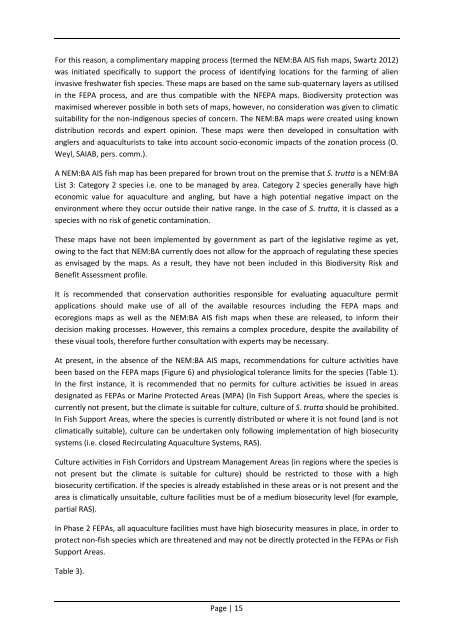Brown trout Salmo trutta - Department of Agriculture, Forestry and ...
Brown trout Salmo trutta - Department of Agriculture, Forestry and ...
Brown trout Salmo trutta - Department of Agriculture, Forestry and ...
You also want an ePaper? Increase the reach of your titles
YUMPU automatically turns print PDFs into web optimized ePapers that Google loves.
For this reason, a complimentary mapping process (termed the NEM:BA AIS fish maps, Swartz 2012)was initiated specifically to support the process <strong>of</strong> identifying locations for the farming <strong>of</strong> alieninvasive freshwater fish species. These maps are based on the same sub-quaternary layers as utilisedin the FEPA process, <strong>and</strong> are thus compatible with the NFEPA maps. Biodiversity protection wasmaximised wherever possible in both sets <strong>of</strong> maps, however, no consideration was given to climaticsuitability for the non-indigenous species <strong>of</strong> concern. The NEM:BA maps were created using knowndistribution records <strong>and</strong> expert opinion. These maps were then developed in consultation withanglers <strong>and</strong> aquaculturists to take into account socio-economic impacts <strong>of</strong> the zonation process (O.Weyl, SAIAB, pers. comm.).A NEM:BA AIS fish map has been prepared for brown <strong>trout</strong> on the premise that S. <strong>trutta</strong> is a NEM:BAList 3: Category 2 species i.e. one to be managed by area. Category 2 species generally have higheconomic value for aquaculture <strong>and</strong> angling, but have a high potential negative impact on theenvironment where they occur outside their native range. In the case <strong>of</strong> S. <strong>trutta</strong>, it is classed as aspecies with no risk <strong>of</strong> genetic contamination.These maps have not been implemented by government as part <strong>of</strong> the legislative regime as yet,owing to the fact that NEM:BA currently does not allow for the approach <strong>of</strong> regulating these speciesas envisaged by the maps. As a result, they have not been included in this Biodiversity Risk <strong>and</strong>Benefit Assessment pr<strong>of</strong>ile.It is recommended that conservation authorities responsible for evaluating aquaculture permitapplications should make use <strong>of</strong> all <strong>of</strong> the available resources including the FEPA maps <strong>and</strong>ecoregions maps as well as the NEM:BA AIS fish maps when these are released, to inform theirdecision making processes. However, this remains a complex procedure, despite the availability <strong>of</strong>these visual tools, therefore further consultation with experts may be necessary.At present, in the absence <strong>of</strong> the NEM:BA AIS maps, recommendations for culture activities havebeen based on the FEPA maps (Figure 6) <strong>and</strong> physiological tolerance limits for the species (Table 1).In the first instance, it is recommended that no permits for culture activities be issued in areasdesignated as FEPAs or Marine Protected Areas (MPA) (In Fish Support Areas, where the species iscurrently not present, but the climate is suitable for culture, culture <strong>of</strong> S. <strong>trutta</strong> should be prohibited.In Fish Support Areas, where the species is currently distributed or where it is not found (<strong>and</strong> is notclimatically suitable), culture can be undertaken only following implementation <strong>of</strong> high biosecuritysystems (i.e. closed Recirculating Aquaculture Systems, RAS).Culture activities in Fish Corridors <strong>and</strong> Upstream Management Areas (in regions where the species isnot present but the climate is suitable for culture) should be restricted to those with a highbiosecurity certification. If the species is already established in these areas or is not present <strong>and</strong> thearea is climatically unsuitable, culture facilities must be <strong>of</strong> a medium biosecurity level (for example,partial RAS).In Phase 2 FEPAs, all aquaculture facilities must have high biosecurity measures in place, in order toprotect non-fish species which are threatened <strong>and</strong> may not be directly protected in the FEPAs or FishSupport Areas.Table 3).Page | 15
















